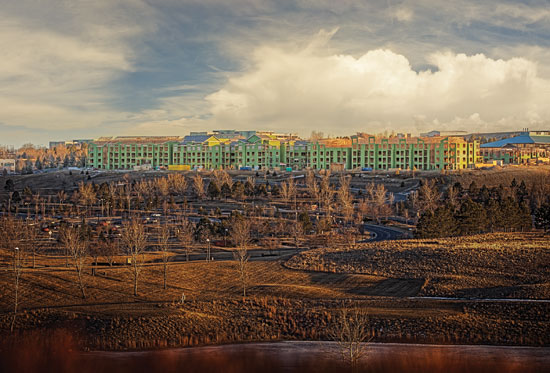Mitigating Risk with High-Performance Structural Wood Panels
Floors—The Importance of a Proper Subfloor
The finished floor is only as good as the subfloor beneath it. Underneath the finished floor is the structural system that supports it and allows it to perform as designed. The ideal subfloor minimizes moisture absorption during the construction process, which can be one of the biggest risks to the integrity of a subfloor. Exposure to snow and rain during construction constitutes a significant moisture issue and can result in edge swell, thickness swell, and possible delamination in the subflooring.

Photo © 2012 Huber Engineered Woods LLC. Photo used with permission of Huber Engineered Woods LLC.
High-performance engineered wood panels show considerably less swelling from moisture absorption after a 24-hour water soak test, when compared to traditional OSB.
Another consequence of excessive moisture in flooring panels is a reduction in fastener holding strength. The problem usually shows up in the form of swelling and buckling hardwood floors. Excessive moisture in the panel transfers to the unfinished backside of the hardwood, resulting in the hardwood floor moving and pulling away from the subfloor due to reduced fastener holding strength. Even if the floors don't buckle visibly, moisture absorption in the subfloor can lead to loss of structural strength that could affect the safety and durability of the project, as well as the overall performance of the floor system and, certainly, result in squeaking and cracking of the floor finish.
Further, unusually heavy materials such as marble or concrete countertop surfaces create excessive loading on the subfloor that can result in unwanted deflection over time, a phenomenon called dead-load creep. Moisture absorption in subfloor panels weakens the panel, further exacerbating the problem. Due to the weight of the materials, the floor continues to deflect (creep) over time, causing cracking of floor surfaces well after the building is complete and the unit occupied. The weight of a traditional 1 ¼-inch-thick granite countertop is 18 pounds per square foot (psf). Most wood framed floors are designed to resist 10 to 15 psf of material weight. This overstress can lead to movement issues later in the life cycle of the floor system.
The likelihood and severity of subfloor problems is highly dependent on the type of subfloor used. The existing options are oriented strand board (OSB), plywood, and engineered high-performance panels (HPP). Historically, OSB has been particularly susceptible to moisture absorption through the face and edges of the panel leading to edge swell, which can require increased sanding of the subfloor panels, increasing the finished flooring costs. Plywood may wick moisture at the seams and therefore is prone to warping, cupping, and veneer delamination.
HPPs designed with advanced moisture-resistant resins and higher wood density than traditional OSB offer better moisture resistance than commodity OSB and plywood, and can come with better exposure warranties. For instance, one manufacturer offers up to 500 days of exposure with a guarantee of no sanding needed due to edge swell. Further, some high-performance panels are designed to offer up to 10 percent better calculated fastener holding power than either plywood or OSB. In addition, they are engineered to exceed PS 2 code standard design values of plywood and commodity OSB in strength and stiffness.3 To help minimize installation defects, some manufacturers of high-performance panels offer precisely milled self-spacing tongue and groove profiles plus a fastening guide for easier installation. To specify these types of high-standard panels, especially in high-traffic or weight-bearing areas, consider subfloor products that have been tested and reported to have higher design values above PS 2 standards discussed in more detail below.
PS 2 vs. ESR 1785—Using Standards to Specify High Performance
Designers can use higher-performing products to meet the demands of today's buyers for achieving durability, efficiency, and structural integrity in subfloors. Standards can help guide in achieving this objective. The minimum standard for structural wood panels is PS 2, a performance standard initiated by the American Plywood Association (now called The Engineered Wood Association) and published by National Institute of Standards and Technology in accordance with the U.S. Dept. of Commerce. The first edition of PS 2, PS 2-92, was published on August 27, 1992. The most current version is PS 2-10. The goal of this standard is to establish structural criteria for assessing the acceptability of wood-based structural use panels for sheathing and single-floor applications. To build risk-mitigating steps into the design process, designers may consider selecting subfloor panels with design properties tested and proven to produce greater, more consistent levels of panel strength, stiffness, and fastener holding power than those required by minimum PS 2 standards. While high-performance materials cannot compensate fully for every risk in the construction process, selecting products that are designed to perform above PS 2 minimum requirements adds a layer of protection into the building design and construction process.
The International Code Council (ICC) Evaluation Service (ES) provides technical evaluations, called Evaluation Service Reports (ESR), for manufacturers that want to validate and qualify their products as having superior design properties beyond those that only meet the PS 2 industry standard. An example of one of these reports is ESR-1785. It signifies that the high-performance panel product evaluated has passed a battery of testing protocols proving greater levels of panel strength, stiffness, and fastener holding power than PS 2. These high-performance panels have been shown to have more than 60 percent better bending strength than OSB or plywood panels of the same dimensions only meeting the minimum PS 2 standards; more than 25 percent better bending stiffness than OSB meeting PS 2 standards; more than 15 percent better bending stiffness than plywood meeting PS 2 standards; and as much as 10 percent better fastener holding power than both PS 2 performing plywood and OSB.

Photo © 2013 Huber Engineered Woods LLC. Photo used with permission of Huber Engineered Woods LLC.
One manufacturer is offering a new approach: high-performance panels with an integrated weather barrier and taped seams that install faster than traditional OSB and building wrap.









